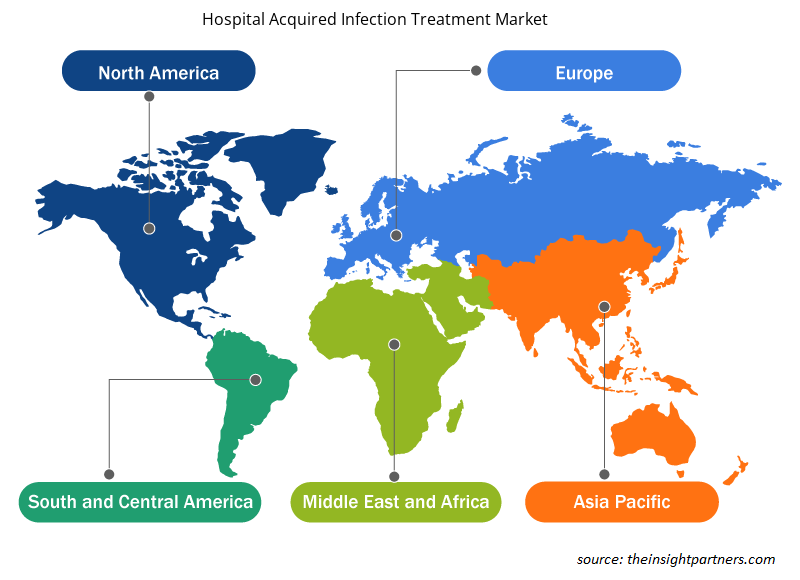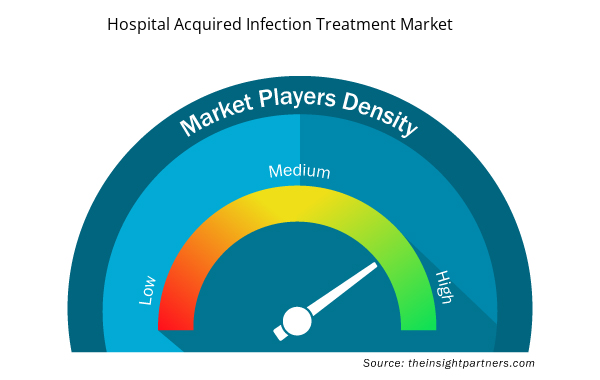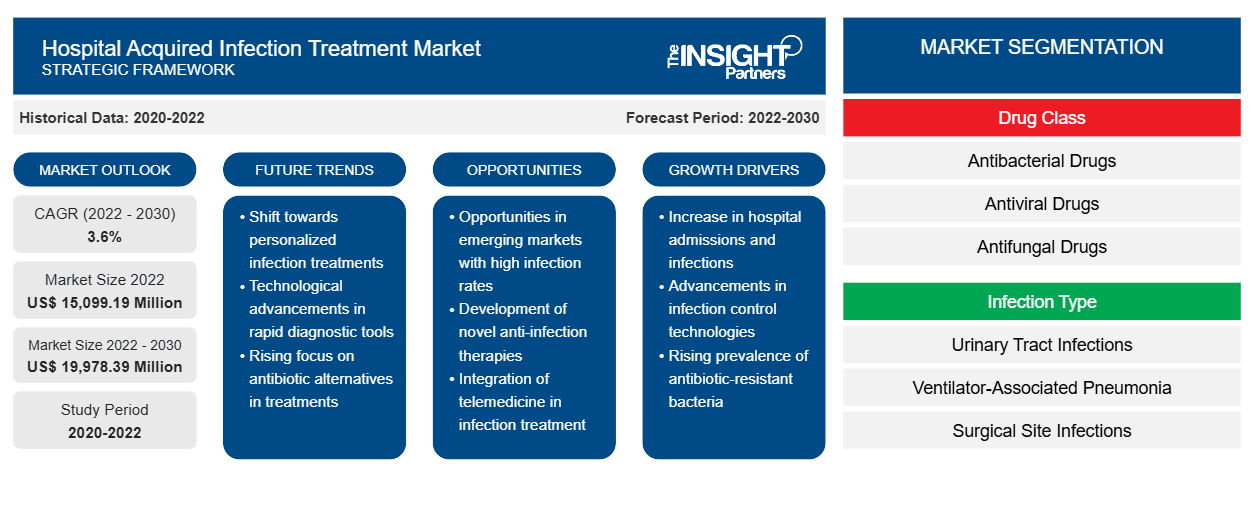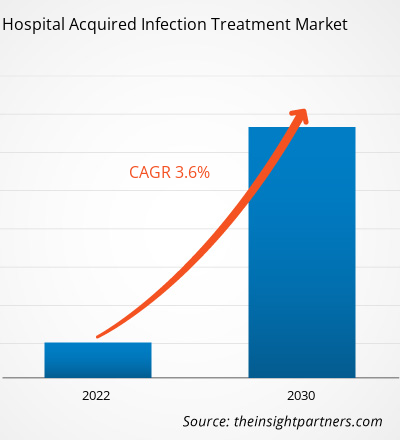[Rapporto di ricerca] Si prevede che il mercato del trattamento delle infezioni acquisite in ospedale crescerà da 15.099,19 milioni di dollari nel 2022 a 19.978,39 milioni di dollari entro il 2030; si prevede che registrerà un CAGR del 3,6% dal 2022 al 2030.
Approfondimenti di mercato e opinioni degli analisti:
Le infezioni nosocomiali (HAI), note anche come infezioni nosocomiali, possono svilupparsi in vari contesti, tra cui ospedali, istituti di assistenza a lungo termine e ambulatoriali, e possono anche manifestarsi dopo la dimissione. Le HAI possono anche riguardare infezioni professionali che colpiscono gli operatori sanitari. I fattori chiave che guidano la crescita del mercato del trattamento delle infezioni nosocomiali sono l'elevata prevalenza di HAI e la crescente attenzione alla sicurezza dei pazienti e alla qualità dell'assistenza. Tuttavia, la minaccia della resistenza antimicrobica ostacola la crescita del mercato del trattamento delle infezioni nosocomiali .
Fattori trainanti e limiti della crescita:
Le infezioni del flusso sanguigno associate al catetere centrale, le infezioni del tratto urinario associate al catetere e la polmonite associata alla ventilazione sono alcuni esempi di infezioni correlate all'assistenza sanitaria (HAI). Queste infezioni, note come infezioni del sito chirurgico, possono verificarsi anche nei siti chirurgici. Secondo il rapporto dei Centers for Disease Control and Prevention (CDC) "2020 National and State Healthcare-Associated Infections Progress Report" pubblicato nel 2021, i casi di infezioni del flusso sanguigno associate al catetere centrale, batteriemia da Staphylococcus aureus resistente alla meticillina (MRSA) ed eventi associati alla ventilazione sono aumentati rispettivamente del 24%, 35% e 15% negli Stati Uniti tra il 2019 e il 2020.
Inoltre, secondo il rapporto di gennaio 2022 del National Healthcare Safety Network (NHSN), le infezioni del tratto urinario (UTI) sono il quinto tipo più comune di infezione associata all'assistenza sanitaria. Le UTI rappresentano oltre il 9,5% delle condizioni ospedaliere per acuti. L'infezione del tratto urinario associata al catetere (CAUTI) è causata dai cateteri urinari utilizzati per drenare l'urina dalla vescica. La CAUTI è una delle infezioni più frequenti tra i pazienti ospedalizzati con UTI. Secondo i Centers for Disease Control and Prevention (CDC), quasi il 75% delle infezioni è correlato a un catetere urinario. Durante la degenza ospedaliera, dal 15% al 25% dei pazienti ospedalizzati ha bisogno di utilizzare cateteri urinari. L'uso prolungato del catetere urinario è il fattore di rischio più importante per contrarre la CAUTI. Le complicazioni della CAUTI comportano sofferenza per il paziente, ricoveri ospedalieri prolungati, maggiori costi di trattamento e persino la morte.
Inoltre, secondo il CDC, le infezioni delle vie urinarie sono responsabili di oltre 13.000 decessi ogni anno. La cistite acuta non complicata causa circa sei giorni di disagio, con conseguenti circa 7 milioni di visite ambulatoriali ogni anno a un costo di 1,6 miliardi di dollari. Di conseguenza, il numero crescente di casi di infezioni ospedaliere comporta un notevole onere finanziario per il sistema sanitario. La crescente prevalenza di CAUTI, combinata con la crescente domanda di farmaci per il trattamento, sta spingendo il mercato.
Tuttavia, la resistenza antimicrobica rappresenta una sfida significativa per il trattamento delle infezioni ospedaliere, limitando l'efficacia degli agenti antimicrobici esistenti e rendendo necessario lo sviluppo di nuove strategie di trattamento e alternative antimicrobiche per combattere efficacemente i patogeni resistenti.
Personalizza questo report in base alle tue esigenze
Riceverai la personalizzazione gratuita di qualsiasi report, comprese parti di questo report, o analisi a livello nazionale, pacchetto dati Excel, oltre a usufruire di grandi offerte e sconti per start-up e università
- Scopri le principali tendenze di mercato in questo rapporto.Questo campione GRATUITO includerà analisi di dati che spaziano dalle tendenze di mercato alle stime e alle previsioni.
Segmentazione e ambito del report:
Il mercato globale del trattamento delle infezioni acquisite in ospedale è segmentato in base alla classe di farmaci, al tipo di infezione e al canale di distribuzione. In base alla classe di farmaci, il mercato del trattamento delle infezioni acquisite in ospedale è segmentato in farmaci antibatterici, farmaci antivirali , farmaci antimicotici e altri. In base al tipo di infezione, il trattamento delle infezioni acquisite in ospedale è differenziato in infezioni del tratto urinario, polmonite associata alla ventilazione, infezioni del sito chirurgico, infezioni del flusso sanguigno e altre infezioni ospedaliere. In base al canale di distribuzione, il mercato è segmentato in farmacie ospedaliere, farmacie al dettaglio, e-commerce e altri. Il mercato del trattamento delle infezioni acquisite in ospedale, in base alla geografia, è segmentato in Nord America (Stati Uniti, Canada e Messico), Europa (Germania, Francia, Italia, Regno Unito, Russia e resto d'Europa), Asia Pacifico (Australia, Cina, Giappone, India, Corea del Sud e resto dell'Asia Pacifico), Medio Oriente e Africa (Sudafrica, Arabia Saudita, Emirati Arabi Uniti e resto del Medio Oriente e Africa) e Sud e Centro America (Brasile, Argentina e resto del Sud e Centro America).
Analisi segmentale:
Il mercato del trattamento delle infezioni acquisite in ospedale, per classe di farmaci, è segmentato in farmaci antibatterici, farmaci antivirali, farmaci antimicotici e altri. Il segmento dei farmaci antibatterici ha detenuto la quota di mercato più grande nel 2022 e si prevede che registrerà il CAGR più elevato nel periodo 2022-2030.
Il mercato del trattamento delle infezioni acquisite in ospedale, per tipo di infezione, è segmentato in infezioni del tratto urinario , polmonite associata alla ventilazione, infezioni del sito chirurgico, infezioni del flusso sanguigno e altre infezioni ospedaliere. Il segmento delle infezioni del tratto urinario ha detenuto la quota di mercato più grande nel 2022. Tuttavia, si prevede che il segmento della polmonite associata alla ventilazione registrerà il CAGR più elevato dal 2022 al 2030.
Il mercato del trattamento delle infezioni acquisite in ospedale, per canale di distribuzione, è segmentato in farmacie ospedaliere, farmacie al dettaglio, e-commerce e altri. Nel 2022, il segmento delle farmacie ospedaliere ha detenuto la quota di mercato maggiore e si prevede che lo stesso segmento registrerà il CAGR più elevato nel periodo 2022-2030.
Analisi regionale:
In base alla geografia, il mercato globale del trattamento delle infezioni ospedaliere è suddiviso in cinque regioni chiave: Nord America, Europa, Asia Pacifico, Sud e Centro America, Medio Oriente e Africa.
Nel 2022, il Nord America deteneva la quota maggiore del mercato globale del trattamento delle infezioni acquisite in ospedale. Gli Stati Uniti hanno un'elevata prevalenza di HAI, che spinge la crescita del mercato del trattamento delle infezioni acquisite in ospedale. Secondo il CDC, in un dato giorno, circa 1 paziente ospedaliero su 31 ha almeno una HAI. Allo stesso modo, secondo l'Office of Disease Prevention and Health Promotion, le HAI e altre infezioni possono portare alla sepsi e causano circa 1,7 milioni di casi di malattia e 270.000 decessi all'anno negli Stati Uniti. Pertanto, l'elevata prevalenza di HAI tra le persone negli Stati Uniti alimenta la crescita del mercato del trattamento delle infezioni acquisite in ospedale.
Sviluppi del settore e opportunità future:
Di seguito sono elencate le varie iniziative intraprese dai principali attori che operano nel mercato globale del trattamento delle infezioni ospedaliere:
- A maggio 2023, Innoviva Specialty Therapeutics ha annunciato che la Food and Drug Administration (FDA) statunitense aveva approvato XACDURO (sulbactam per iniezione; durlobactam per iniezione), confezionato congiuntamente per uso endovenoso in pazienti di età pari o superiore a 18 anni per il trattamento della polmonite batterica acquisita in ospedale e della polmonite batterica associata alla ventilazione (HABP/VABP) causata da isolati sensibili del complesso Acinetobacter baumannii-calcoaceticus (Acinetobacter). Innoviva Specialty Therapeutics ha dichiarato di essere focalizzata sulla fornitura di terapie innovative in terapia intensiva e malattie infettive.
- Nel maggio 2023, i ricercatori dell'Indian Institute of Science Education and Research (IISER) di Pune e del Central Drug Research Institute (CSIR-CDRI) di Lucknow hanno annunciato di aver scoperto un potenziale nuovo antibiotico contro l'Acinetobacter baumannii, che causa frequentemente infezioni ospedaliere.
- Nel settembre 2020, Shionogi & Co Ltd ha annunciato che la FDA aveva approvato una domanda supplementare di nuovo farmaco (sNDA) per FETROJA (cefiderocol) per il trattamento di pazienti di età pari o superiore a 18 anni affetti da polmonite batterica nosocomiale e polmonite batterica associata alla ventilazione (HABP/VABP) causate da microrganismi Gram-negativi sensibili quali Enterobacter cloacae complex, Klebsiella pneumoniae, Acinetobacter baumannii complex, Escherichia coli, Pseudomonas aeruginosa e Serratia marcescens.
- Nel giugno 2020, Merck ha annunciato che la Food and Drug Administration (FDA) statunitense aveva approvato una domanda supplementare di nuovo farmaco (sNDA) per RECARBRIO (imipenem, cilastatina e relebactam) per il trattamento di pazienti di età pari o superiore a 18 anni affetti da polmonite batterica acquisita in ospedale e polmonite batterica associata alla ventilazione (HABP/VABP), causate da microrganismi Gram-negativi sensibili quali il complesso Acinetobacter calcoaceticus-baumannii, Klebsiella oxytoca, Klebsiella pneumoniae, Enterobacter cloacae, Escherichia coli, Haemophilus influenzae, Klebsiella aerogenes, Pseudomonas aeruginosa e Serratia marcescens.
Approfondimenti regionali sul mercato del trattamento delle infezioni contratte in ospedale
Le tendenze regionali e i fattori che influenzano il mercato del trattamento delle infezioni acquisite in ospedale durante il periodo di previsione sono stati ampiamente spiegati dagli analisti di Insight Partners. Questa sezione discute anche i segmenti del mercato del trattamento delle infezioni acquisite in ospedale e la geografia in Nord America, Europa, Asia Pacifico, Medio Oriente e Africa e America meridionale e centrale.

- Ottieni i dati specifici regionali per il mercato del trattamento delle infezioni contratte in ospedale
Ambito del rapporto di mercato sul trattamento delle infezioni contratte in ospedale
| Attributo del report | Dettagli |
|---|---|
| Dimensioni del mercato nel 2022 | 15.099,19 milioni di dollari USA |
| Dimensioni del mercato entro il 2030 | 19.978,39 milioni di dollari USA |
| CAGR globale (2022-2030) | 3,6% |
| Dati storici | 2020-2022 |
| Periodo di previsione | 2022-2030 |
| Segmenti coperti | Per classe di farmaci
|
| Regioni e Paesi coperti | America del Nord
|
| Leader di mercato e profili aziendali chiave |
|
Densità degli operatori del mercato del trattamento delle infezioni contratte in ospedale: comprendere il suo impatto sulle dinamiche aziendali
Il mercato del trattamento delle infezioni acquisite in ospedale sta crescendo rapidamente, spinto dalla crescente domanda degli utenti finali dovuta a fattori quali l'evoluzione delle preferenze dei consumatori, i progressi tecnologici e una maggiore consapevolezza dei benefici del prodotto. Con l'aumento della domanda, le aziende stanno ampliando le loro offerte, innovando per soddisfare le esigenze dei consumatori e capitalizzando sulle tendenze emergenti, il che alimenta ulteriormente la crescita del mercato.
La densità degli operatori di mercato si riferisce alla distribuzione di aziende o società che operano in un particolare mercato o settore. Indica quanti concorrenti (operatori di mercato) sono presenti in un dato spazio di mercato in relazione alle sue dimensioni o al valore di mercato totale.
Le principali aziende che operano nel mercato del trattamento delle infezioni nosocomiali sono:
- Merck & Co Inc
- Pfizer Inc
- AbbVie Inc
- Paratek Pharmaceuticals Inc
- Eugia Stati Uniti LLC
Disclaimer : le aziende elencate sopra non sono classificate secondo un ordine particolare.

- Ottieni una panoramica dei principali attori del mercato del trattamento delle infezioni contratte in ospedale
Scenario competitivo e aziende chiave:
Merck & Co Inc, Pfizer Inc, AbbVie Inc, Paratek Pharmaceuticals Inc, Eugia US LLC, Abbott Laboratories, Cumberland Pharmaceuticals Inc, Innoviva Specialty Therapeutics Inc, Cipla Ltd ed Eli Lilly and Company sono tra i principali attori che operano nel mercato del trattamento delle infezioni acquisite in ospedale. Queste aziende si concentrano su nuove tecnologie, progressi nei prodotti esistenti ed espansioni geografiche per soddisfare la crescente domanda dei consumatori in tutto il mondo e aumentare la loro gamma di prodotti nei portafogli specialistici.
- Analisi storica (2 anni), anno base, previsione (7 anni) con CAGR
- Analisi PEST e SWOT
- Valore/volume delle dimensioni del mercato - Globale, regionale, nazionale
- Industria e panorama competitivo
- Set di dati Excel



Report Coverage
Revenue forecast, Company Analysis, Industry landscape, Growth factors, and Trends

Segment Covered
This text is related
to segments covered.

Regional Scope
North America, Europe, Asia Pacific, Middle East & Africa, South & Central America

Country Scope
This text is related
to country scope.
Domande frequenti
Hospital-acquired infections (HAI), also known as nosocomially acquired infections. HAIs are infections acquired during medical treatment that were not present at the time of admission. They may develop in a variety of settings, including hospitals, long-term care institutions, and ambulatory settings, and they can also appear after discharge. HAIs can also involve occupational infections that affect healthcare workers.
The hospital acquired infection treatment market majorly consists of the players, including Merck & Co Inc, Pfizer Inc, AbbVie Inc, Paratek Pharmaceuticals Inc, Eugia US LLC, Abbott Laboratories, Cumberland Pharmaceuticals Inc, Innoviva Specialty Therapeutics Inc, Cipla Ltd, and Eli Lilly and Company.
Key factors driving the hospital acquired infection treatment market growth include the high prevalence of hospital-acquired infections (HAI) and the growing focus on patient safety and quality care.
The hospital acquired infection treatment market was valued at US$ 15,099.19 million in 2022.
The hospital acquired infection treatment market, by distribution channel, is segmented into hospital pharmacies, retail pharmacies, e-commerce, and others. In 2022, the hospitals pharmacies segment held the largest market share, and the same segment is anticipated to register the highest CAGR during 2022–2030.
The hospital acquired infection treatment market is expected to be valued at US$ 19,978.39 million in 2030.
The hospital acquired infection treatment market, by infection type, is segmented into urinary tract infections, ventilator-associated pneumonia, surgical site infections, bloodstream infections, and other hospital infections. The urinary tract infections segment held a larger market share in 2022; However, the ventilator-associated pneumonia segment is anticipated to register a higher CAGR during 2022-2030.
The hospital acquired infection treatment market, by drug class, is segmented into antibacterial drugs, antiviral drugs, antifungal drugs, and others. The antibacterial drugs segment held a larger market share in 2022, and the same segment is anticipated to register a higher CAGR during 2022-2030.
Trends and growth analysis reports related to Life Sciences : READ MORE..
The List of Companies - Hospital Acquired Infection Treatment Market
- Merck & Co Inc
- Pfizer Inc
- AbbVie Inc
- Paratek Pharmaceuticals Inc
- Eugia US LLC
- Abbott Laboratories
- Cumberland Pharmaceuticals Inc
- Innoviva Specialty Therapeutics Inc
- Cipla Ltd
- Eli Lilly and Company
The Insight Partners performs research in 4 major stages: Data Collection & Secondary Research, Primary Research, Data Analysis and Data Triangulation & Final Review.
- Data Collection and Secondary Research:
As a market research and consulting firm operating from a decade, we have published and advised several client across the globe. First step for any study will start with an assessment of currently available data and insights from existing reports. Further, historical and current market information is collected from Investor Presentations, Annual Reports, SEC Filings, etc., and other information related to company’s performance and market positioning are gathered from Paid Databases (Factiva, Hoovers, and Reuters) and various other publications available in public domain.
Several associations trade associates, technical forums, institutes, societies and organization are accessed to gain technical as well as market related insights through their publications such as research papers, blogs and press releases related to the studies are referred to get cues about the market. Further, white papers, journals, magazines, and other news articles published in last 3 years are scrutinized and analyzed to understand the current market trends.
- Primary Research:
The primarily interview analysis comprise of data obtained from industry participants interview and answers to survey questions gathered by in-house primary team.
For primary research, interviews are conducted with industry experts/CEOs/Marketing Managers/VPs/Subject Matter Experts from both demand and supply side to get a 360-degree view of the market. The primary team conducts several interviews based on the complexity of the markets to understand the various market trends and dynamics which makes research more credible and precise.
A typical research interview fulfils the following functions:
- Provides first-hand information on the market size, market trends, growth trends, competitive landscape, and outlook
- Validates and strengthens in-house secondary research findings
- Develops the analysis team’s expertise and market understanding
Primary research involves email interactions and telephone interviews for each market, category, segment, and sub-segment across geographies. The participants who typically take part in such a process include, but are not limited to:
- Industry participants: VPs, business development managers, market intelligence managers and national sales managers
- Outside experts: Valuation experts, research analysts and key opinion leaders specializing in the electronics and semiconductor industry.
Below is the breakup of our primary respondents by company, designation, and region:

Once we receive the confirmation from primary research sources or primary respondents, we finalize the base year market estimation and forecast the data as per the macroeconomic and microeconomic factors assessed during data collection.
- Data Analysis:
Once data is validated through both secondary as well as primary respondents, we finalize the market estimations by hypothesis formulation and factor analysis at regional and country level.
- Macro-Economic Factor Analysis:
We analyse macroeconomic indicators such the gross domestic product (GDP), increase in the demand for goods and services across industries, technological advancement, regional economic growth, governmental policies, the influence of COVID-19, PEST analysis, and other aspects. This analysis aids in setting benchmarks for various nations/regions and approximating market splits. Additionally, the general trend of the aforementioned components aid in determining the market's development possibilities.
- Country Level Data:
Various factors that are especially aligned to the country are taken into account to determine the market size for a certain area and country, including the presence of vendors, such as headquarters and offices, the country's GDP, demand patterns, and industry growth. To comprehend the market dynamics for the nation, a number of growth variables, inhibitors, application areas, and current market trends are researched. The aforementioned elements aid in determining the country's overall market's growth potential.
- Company Profile:
The “Table of Contents” is formulated by listing and analyzing more than 25 - 30 companies operating in the market ecosystem across geographies. However, we profile only 10 companies as a standard practice in our syndicate reports. These 10 companies comprise leading, emerging, and regional players. Nonetheless, our analysis is not restricted to the 10 listed companies, we also analyze other companies present in the market to develop a holistic view and understand the prevailing trends. The “Company Profiles” section in the report covers key facts, business description, products & services, financial information, SWOT analysis, and key developments. The financial information presented is extracted from the annual reports and official documents of the publicly listed companies. Upon collecting the information for the sections of respective companies, we verify them via various primary sources and then compile the data in respective company profiles. The company level information helps us in deriving the base number as well as in forecasting the market size.
- Developing Base Number:
Aggregation of sales statistics (2020-2022) and macro-economic factor, and other secondary and primary research insights are utilized to arrive at base number and related market shares for 2022. The data gaps are identified in this step and relevant market data is analyzed, collected from paid primary interviews or databases. On finalizing the base year market size, forecasts are developed on the basis of macro-economic, industry and market growth factors and company level analysis.
- Data Triangulation and Final Review:
The market findings and base year market size calculations are validated from supply as well as demand side. Demand side validations are based on macro-economic factor analysis and benchmarks for respective regions and countries. In case of supply side validations, revenues of major companies are estimated (in case not available) based on industry benchmark, approximate number of employees, product portfolio, and primary interviews revenues are gathered. Further revenue from target product/service segment is assessed to avoid overshooting of market statistics. In case of heavy deviations between supply and demand side values, all thes steps are repeated to achieve synchronization.
We follow an iterative model, wherein we share our research findings with Subject Matter Experts (SME’s) and Key Opinion Leaders (KOLs) until consensus view of the market is not formulated – this model negates any drastic deviation in the opinions of experts. Only validated and universally acceptable research findings are quoted in our reports.
We have important check points that we use to validate our research findings – which we call – data triangulation, where we validate the information, we generate from secondary sources with primary interviews and then we re-validate with our internal data bases and Subject matter experts. This comprehensive model enables us to deliver high quality, reliable data in shortest possible time.


 Ottieni un campione gratuito per questo repot
Ottieni un campione gratuito per questo repot